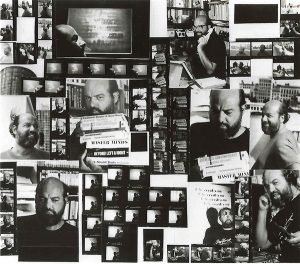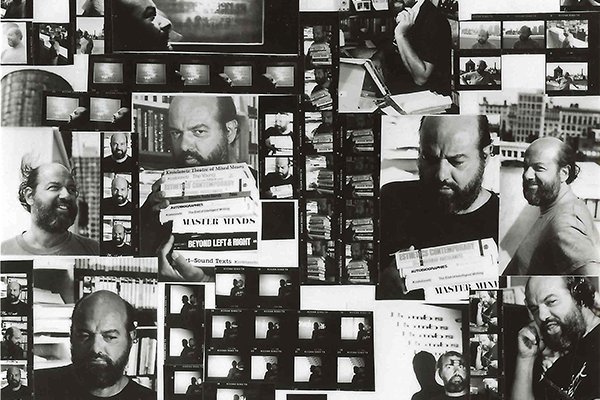From Richard Kostalanetz’s A Writer’s Torah
A Selection by DeWitt Henry, WTP Prose Editor

Individual entries on Richard Kostelanetz’s work in several fields appear in various editions of Readers Guide to Twentieth-Century Writers, Merriam-Webster Encyclopedia of Literature, Contemporary Poets, Contemporary Novelists, Postmodern Fiction, Webster’s Dictionary of American Writers, The HarperCollins Reader’s Encyclopedia of American Literature, Baker’s Biographical Dictionary of Musicians, Directory of American Scholars, Who’s Who in America, Who’s Who in the World, Who’s Who in American Art, NNDB.com, Wikipedia.com, and Britannica.com, among other distinguished directories. Otherwise, he survives in New York, where he was born, unemployed and thus overworked.
1.
Since aphorisms don’t earn much money from magazines that pay by the word or from anthologies or from translations, and never score film rights, they rank with haiku, say, among the least remunerative literary genres.
2.
What marks the human temperament of the aphorist? Impatience? Precision? Literary courage? Skepticism? Superior insight? Smug smarts? A compulsion to have the last words in any dialogue? All of the above?
3.
Was there ever a witless aphorist—one who never provoked at least a smile?
4.
Though my poems and essays have been anthologized for decades, the only aphorism collection to reprint me is Peter’s Quotations (1977), which attributes this to me: “The adherents of the status quo never had it so bad. There has always been a conflict between those who feel their values are eternal and those who feel they are relative.” Pleased though I am to be placed immediately after Emma Goldman, Charles Darwin, and Sigmund Freud, I don’t remember where these words (purportedly mine) came from; nor do I think them particularly good.
5.
Readers of these thoughts are invited to identify which are so different from the others—in style, in intelligence, in point of view—that they might have been stolen from or written by someone else.
6.
The most valuable literature offers experience or insights that readers haven’t had.
7.
If you wish to explore alternative exposition, as I’ve done, consider choosing a subject you know well, such as your own life, as I’ve done.
8.
Of the many aphorisms Ernest Hemingway reportedly said, as distinct from writing, the most memorable to me is “Retire? How the hell can a writer retire?” Hem solved literary paralysis in his own career by committing suicide, in his early sixties.
9.
Nearly all of “W. H. Auden’s Aphorisms on Writing,” found on the Internet, struck me as unnecessarily elaborate.
10.
More work distinguishes Art from doodling.
11.
A great essayist about experience persuades a reader that he knows some of the reader’s personal secrets.
12.
Books to be dipped into, such as the Torah, aren’t necessarily inferior to those meant to be read from beginning to end.
13.
Choice words live longer than any man.
14.
Aphorisms hit as the aphorist runs.
15.
Never should an aspiring aphorist want to write like anybody else dead or alive.
16.
Strong aphorisms resemble the best visual art in establishing the verbal equivalent of an “after-image” that sticks in readers’ heads.
17.
Literary style comes as much from omission as commission.
18.
Don’t dare write aphorisms unless you can write them originally; writing familiarly is too easy.
19.
The more platitudinous the writer’s words the more suspicious should the reader be.
20.
Maxims force both a writer and his reader to pay careful attention to every word.
21.
Writers of aphorisms are more likely to have better days (and weaker days) than journalists, say.
22.
To rewrite my aphorism muse John Robert Colombo, “So much contemporary poetry reads as if it was written by everybody or nobody.”
23.
To realize artistic ambition in a genre plagued by failure, such as the writing of aphorisms, the writer’s work must overcome disadvantages.
24.
The strategic problem in aphorisms is writing enough words to be clearly understood and yet remembered.
25.
The mark of a true intellectual is not repeating currently fashionable ideas but reinterpreting them.
26.
Fads routinely undermine intelligence as well as style, especially in writing (re)read decades later.
27.
The opposite of austere is not loud but sloppy.
28.
Writers thought thick usually are indeed unperceptive.
29.
More published aphorisms are obscure than false.
30.
Establishing an optimal sequence for publishing aphorisms is as problematic as actually writing them.

